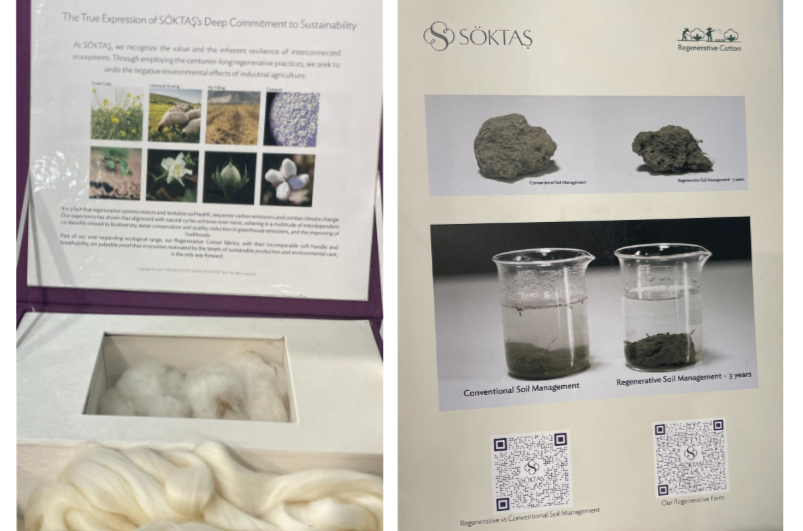
Söktaş, a company based in the Asian coast of Türkiye, specialises in designing fabrics predominantly from cotton and cotton blends mostly.
It has been working on a regenerative cotton farming project in collaboration with the Stella McCartney Foundation and United Nations Economic Commission for Europe (UNECE) for the last five years. The company also has family-owned fields where they practice regenerative cotton agriculture, located just 7kms away from its cotton factory.
Durgun emphasised the importance of sustainability as a theme for Söktaş and also the way forward for the world. For her, it comes down to how you approach things or where you make a change in the value chain.
She told Just Style: “This is a step forward in agriculture and growing cotton which otherwise consumes a lot of water. But with regenerative farming, what we are doing is reversing the cycle back to the very old times where we let nature do the work.”
Taking care of the soil’s needs
Söktaş’ Durgun explained how regenerative farming works for the company. In contrast to general farming practice in the region, Söktaş grows only one crop of cotton while the rest of the year is used to grow a ‘cover crop’.
The cover crop can be a mixture of plants and herbs, based on an analysis of the soil which is done manually.

US Tariffs are shifting - will you react or anticipate?
Don’t let policy changes catch you off guard. Stay proactive with real-time data and expert analysis.
By GlobalDataBecause the needs of the soil are not the same every time, Durgun explained that the soil has to be analysed and, based on the results of what is lacking and needed, more phosphorus or nitrogen, or other minerals can be added to the cover crop.
Durgun said: “As the plants grow, they grow through the roots and create that biodiversity in the soil. So we have plants growing, and earthworms and everything which keeps the moisture in the soil. This way you need less irrigation. We also have adopted grazing, so the livestock eats grass which further strengthens the growth and also gives natural fertilisers. There is no tilling and hence no fuel or diesel is used and the cotton grows with less water.”
Söktaş started regenerative farming with just five hectares, although Durgun said it plans to expand it by doubling this next year and again the year after.
Making the process transparent through blockchain
As part of the collaborative project with Stella McCartney, Söktaş also engaged with a professor from US. Durgun said this was part of Söktaş’ holistic approach, wherein the professor, who is a biochemist within agriculture, helps the company collect soil data, analyse it and plant accordingly.
Durgun added that a part of this project aims to make the process transparent by adding it to the UNECE blockchain platform.
The UNECE blockchain platform includes input from all collaborators in a T-shirt’s value chain, asking them to provide proof of their production practices. This could include certifications and standards, with the overall aim of proving that a T-shirt has been manufactured using regenerative cotton.
In a statement, Söktaş said: “To create more traceable and transparent activities and products in the fashion industry, we collaborated with Stella McCartney and UNECE to develop a blockchain Pilot use case based on regenerative agriculture, to trace the product from farm to shelf to through documentary evidence and to prove sustainability credentials.”
Growing regenerative cotton
Söktaş’ initiative provides a stark comparison between conventional and regenerative farming methods. Durgun illustrated this through a live test that she had witnessed.
Two jars were filled with water. In one jar some conventional soil was added and to the other, a block of regenerative soil. After leaving both jars for ten minutes, the jar with conventional soil looked blurry because the soil was dissolved with no moisture or roots to bind it together. “This is what we call soil erosion,” Durgun explained.

While the other jar containing regenerative soil shows the lump of soil held together. Durgun said that some bubbles could also be seen at the surface because of the moisture content in the regenerative soil, along with small plants, organic matter and earthworms which further held the soil together like a rock.
Durgun said that such initiatives and practices are exciting for the company to share with its stakeholders.
Currently, Söktaş relies on little cotton from this yield because of the limit in capacity, but the company has plans to expand the project.
Despite the promising outcomes, Durgun acknowledged the challenges associated with transitioning to regenerative cotton farming. She noted that since they do not pressure the environment by growing two crops simultaneously, this often results in less income for farmers, even though the result is good and the yield is promising.
On the whole, Durgun believes, the switch towards regenerative farming comes down to all the players joining hands – including brands, producers and manufacturers – everybody.
“Everybody has to believe in this because there is a period where the income will not be what it was before, but the results are promising, and the yield increases. So there has to be a holistic approach, a belief and an acceptance and all stakeholders have to hold on to it. We all as a world, and as textile people we want to go green, but there are costs linked to it and we all need to understand that as well,” Durgun concluded.
As Söktaş continues to expand its regenerative cotton farming initiative, the message is clear: sustainable fashion is not just a trend but a necessity. By pioneering innovative agricultural practices and fostering collaboration within the industry, Söktaş sets a precedent for a more sustainable future in fashion—one where environmental stewardship and profitability go hand in hand.



